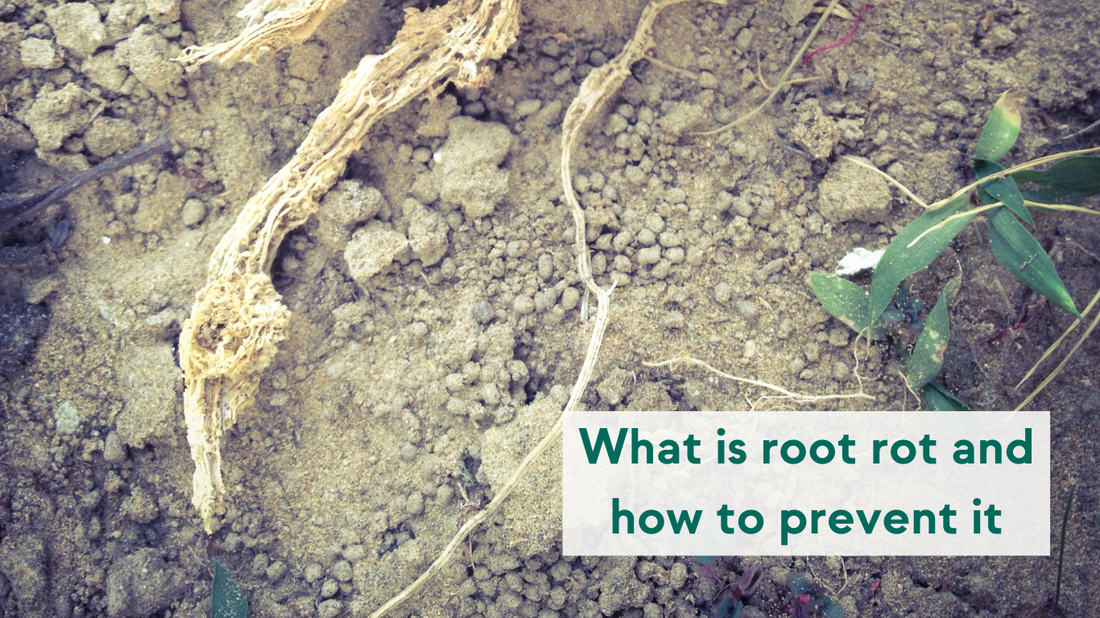
What is root rot?
Root rot is a very common houseplant disease that's usually caused by a bacterial or fungal infection on the roots of a plant. These microorganisms thrive in wet soil and eventually cause a plant's roots to suffocate and rot. Roots are also likely to rot when they are exposed to overly moist conditions for too long.
The roots are the most important part of a plant: They keep things running and fuel all the foliage you see above the surface. So when they die off, the rest of the plant will inevitably do the same.
Root rot is a condition that, if left untreated, will kill plants.
Because the first symptoms of root rot occur beneath the soil, gardeners are often not aware of the problem until it is advanced and it’s too late to save the plant. When plants start showing symptoms of root rot, such as yellow leaves or stunted growth, take action immediately to resolve the problem.

Plants in soils too dense for water to drain out efficiently, or in containers that lack effective drainage holes, are the most susceptible to root rot. While container plants are at risk more than outdoors ones, garden plants are not immune to root rot.
Most garden root rot issues can be prevented by taking steps to improve soil drainage before planting like preparing a good soil mix. While it may seem like excessive water is the cause of root rot, the problem starts because too much water provides the perfect environment for the real cause: fungus.
How to identify root rot:
One of the easiest ways to identify root rot is by observing the plant. Yellow and black leaves are one indication of potential rot. These discolored leaves might also look dry and shriveled, despite regular watering.
If small fungus gnats have settled around your plant, it's another bad sign. That usually indicates that the soil is too moist and organic matter is starting to rot.
The last clue to look out for – or rather, to smell for – is a sour, rotting eggy odor emanating from your plants’ soil.
If you notice any of these signs, it's time to take your plant out of its pot and analyze its roots up close. If the roots are brown or black and soft or mushy instead of a healthy, creamy white, it indicates root rot. Once you diagnose root rot, it's time to do some damage control.

What causes root rot?
There are a few reasons your plant's roots might be in jeopardy. Here are the most common causes of root rot:
- Overwatering:This is by far the most common cause of root rot. Different types of plants have different water needs. If you water yours too frequently or heavily, its soil will get oversaturated and become a breeding ground for fungi and bacteria.
- Poor drainage: This is also related to overwatering. If your plant's pot doesn't have a drainage hole, excess water won't be able to sip from it, leading to overly moist soil. While adding small rocks and pebbles to the bottom of a closed pot can increase aeration slightly, most experts recommend avoiding pots that don't have holes altogether.
- Underwatering:In some cases, not watering your plant enough can eventually lead to root rot too. Roots begin to shrink and shrivel when their soil is too dry. If you forget to water your plant for a while and then flood it with water, it can shock the fragile root system.
How to recover a plant from root rot
Some plants can recover from root rot, but it always comes down to how quickly you can spot the problem as it really depends on how much of the root system has been damaged. Once you lift your plant out of its pot and assess its roots, see if there are any that still look light in color and are thick enough to withstand some pressure. If your plant still has some intact roots throughout, it might be salvageable.
Here's a simple procedure for saving plants that have root rot:
- Take clean pruners and remove all the brown or black rotting roots.
- After removing all the unhealthy roots, wash the roots under tepid water to remove any fungus or rotten material from the roots.
- Also remove any yellow or blackened leaves.
- Pour some ground cinnamon powder onto the cut roots, this is a natural disinfectant that will prevent bacterial spread.
- Repot your plant in a clean container with proper drainage. Use fresh potting soil that is well-draining and an appropriate mix for your particular plant.

If your plant doesn't have enough intact roots to make transplanting worth it, not all hope is lost! You still might be able to grow a new plant from one of its healthy stems or leaf cuttings.
How to avoid root rot in the future
Since root rot is usually caused by excess moisture, proper watering is always the best form of prevention.
Making sure that your plant has proper drainage is also key. If you have a decorative pot that doesn't have a hole in it, drill one yourself, or place your plant in a smaller plastic pot that does have a hole, and sit that pot into the larger decorative one.
Final Thoughts
Root rot harms houseplants' root systems, and it usually happens in soil that's too moist. While it's a major cause of plant death, it is treatable if you catch it early enough. Monitor your plants for discolored leaves, fungus gnats, and gnarly smells to catch this disease before it totally takes over your plant.
If you're prone to overwatering, using a moisture meter or a smart planter might help you break the habit.
But even if you are using truly smart plant care systems like KORU, a great soil ensures your plants will thrive and grow.

